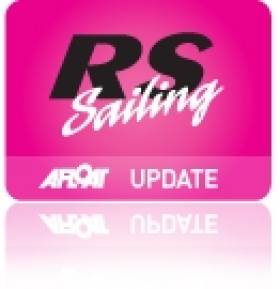Displaying items by tag: Royal St George
RStGYC RS & Laser Series, Best Turnout, Best Wind & Definitely Best Temperature So Far!
#rsgyc – Run by the RStGYC in Dun Laoghaire, Friday night racing for RSs and Lasers served up top notch sport in glorious conditions of sunshine and a warm westerly F 3-4 writes Heather King. Nine RSs came to the line followed by half a dozen Lasers, the latter somewhat depleted by Laser Northerns and Oppie Dad duty in Galway. Still, turnout keeps ticking up nicely.
The RSs had great tussles throughout the fleet and, unbelievably, the second races featured a dead heat for first in the 200s and a really tight photo finish for the win in the 400s. As the photos show, the Lasers were also really, really tight. In the "4s" Andrew Algeo and Paul Nolan took both races in a debut Friday cameo but Eoin Laverty in his brand new boat pushed him all the way in that second race, after leading at every mark. In the "2s" it was Stephen Craig and Conor Foley in race one, holding off SB20/GP14 veteran Mark Nolan while it was the youthful Jack Higgins and Chloe Eggers who crossed together with Craig/Foley in R2. Laser bullets were shared by Chris Arrowsmith and Ross O'Leary, with other podium showings by David Cahill, David Dwyer and Conor O'Leary. Conor enjoyed himself so much he wouldn't sail in and headed back up the Bay into the setting sun ! This PRO could hardly blame him as I looked on jealously.
Back onshore after ; Warm setting sun, BBQ with the Junior racers from the Harbour series, no rush home for work....you know the script !
Two thirds of the series still to go, we'll tag on a third race as we head towards mid-summers.
#rsgyc – The RStGYC May/June Friday Series (open to all comers) for Laser and RS dinghies had another two great races last night writes Heather King. Good to see the increased turnout and we were lucky with a little ridge of higher pressure between a series of lows and by start time the breeze had eased all the way back to a very pleasant 10 knots, blowing out from the direction of Seapoint's Martello Tower.
#rstgyc – Races were rattled off by surely one of the youngest Race Officers Dun Laoghaire has ever seen for adult racing. Adam Hyland, who has represented the George overseas with distinction and topped national rankings in both the 420 and Optimist classes, performed one master-stroke in particular. He noticed he had time pre-start to shift his freshly-laid course 200 yards offshore. He saw fresher breeze and, crucially, big flicks to the left and, had he not relaid, the weather mark would have required a position way South, which would have been a very interesting obstacle course over the West pier !
RSs went off first for 3 rounds W/L and at the first mark the Boys Craig/Foley led in a 200 from Ryan/Murphy in the 400. However, Emmet and Luke in the bigger rig soon showed great speed and downwind angles, allied to slick boathandling, to dominate both races for the rest of the night. Craig/Foley led the 200s home comfortably in race one but were further back in the two lap second race when Clodagh and Adrian Hinkson staged a remarkable comeback on the lead 200 raced by Laser/Fireball ace Justin Maguire. The Hinksons carried a beautiful, soaking downwind course in a softening breeze and, had they not required one final gybe just a few metres from the line, they would surely have pipped Maguire and crew Heather Craig. Downwind finishes sure are interesting !! The other 200 and 400 crews all had their moments in the challenging patchy, shifty conditions.
The Lasers sailed two rounds each time and it was good to see some additional new faces this week in Ross O'Leary, Conor O'Leary and Peter Docherty. Things were competitive, especially when Ross challenged in race One and Conor got well in the mix in race Two. However Patrick Cahill again showed apalling disrespect for his elders, claiming both guns ! This Radial sailor will have no problems at all with the Full rig going forward, that much is clear. It also shows this Friday series is absolutely perfect for younger sailors anywhere close to the transition stage between the smaller Laser rig and the Full. Plus what better way to take a little break from studies on a Friday night ?
Hyland wrapped things up to give his two old sea dog assistants a rest onboard the flagship and things looked decidedly gloomy and dark for 8 o'clock. Sure enough the heavens later opened up but boats were all derigged and pints and burgers were already being guzzled down under cover on the balcony.
We'll welcome more next week for sure as 4 or 5 cyclists were absent, not on the visting Giro D'Italia but away terrifying people with their lycra on the island of Mallorca. Lads, please note the lycra is out on this racetrack, especially "Giro pink". The peloton will no doubt also be boosted by the returning Hugh Sheehy. Expect double figure turnouts in both RSs and Lasers.
Regatta entry here
Two Irish Teams Contest British Team Racing Trophy
#wilsontrophy – Two Irish teams will contest The Wilson Trophy British Open Team Racing Championships are to be held on West Kirby's Marine Lake this weekend (9th – 11th May) and will be hosted by West Kirby Sailing Club (WKSC). Dublin teams from Howth Yacht Club and the Royal St. George YC are travelling to Liverpool for the event now in its 65th year. This unique and spectacular team race sailing event will be welcoming 32 of the finest teams from around the UK, USA and Ireland including three teams from WKSC itself.
Aswell as the Irish participating teams, there will be two Irish umpires at the event. Irish national umpire Cxema Pico is attending and International Judge and national umpire Gordon Davies in also on duty.
The 192 competitors will be sailing in 12-foot dinghies known as Fireflies while under the close observation of some of the best umpires from the UK and overseas. Competition will be fierce this year as some of the traditional teams have disbanded, with sailors joining other teams to try and find that winning formula.
Racing starts at 1pm on Friday 9th May and continues through to late Sunday afternoon. Weather permitting, there will be over 350 fast and cut throat races to watch. The Marine Lake, otherwise known as the 'theatre of dreams', provides a natural amphitheatre where members of the public are encouraged to come and watch the action from the Grandstand on West Kirby promenade (by the old baths). The Visitors Centre and live commentary will also help to explain some of the nuances of the racing to spectators and passers-by.
David Taylor, Commodore of West Kirby Sailing Club, said: "We are thrilled to be hosting this fantastic event, now in its 65th year. It's great to see so many people travelling from near and far to sail on the Marine Lake and enjoy its beautiful surroundings.
"The club is extremely proud to host this event each year and we always aim to provide both the competitors and our local community with a weekend of sporting action that they won't forget."
The three-day event will be an exciting and fun weekend for spectators and competitors alike with a thrilling demonstration of top level sailing, which is free to watch. The final rounds are scheduled to take place on Sunday from 1pm, when the action reaches its climax, with the top eight of 32 teams entering play-offs to take home the celebrated trophy.
The 2014 Wilson Trophy is delighted by the support it has received from many individuals and businesses, including leading sponsors: Carlsberg, Everite Windows, GJW Direct, MI Finance and Speed Medical.
Follow the results at: www.wilsontrophy.co.uk
First RS Aero Dinghy Purchase for Ireland Goes to Royal St. George YC Sailor on Dublin Bay
#rsaero – 63–year–old Daniel McNelis of the Royal St. George YC is the proud owner of the lastest in dinghy designs following a demo of the ultralight RS Aero dinghy on Dublin Bay earlier this week. McNeilis, an amputee, who is an an RS Vario sailor, says the boat planes nicely upwind and 'tacks in a jiffy'.
The RS Aero has been dubbed the 21st century Laser – with the most fundamental difference being ultra-light weight. A full size single hander that, amazingly, weighs 30kg - the same as an Optimist.
Quick thinking RS promoters McCready Sailboats from Hollywood in County Down also recruited Dun Laoghaire sailing superstar Finn Lynch who said the RS Aero is a fun boat to sail. Lynch, who is aiming for Rio 2016 in the full rig Laser dinghy, also says he found the boat 'very quick'.
The 17–year–old, who won an ISAF youth silver medal in 2012, gave a thumbs up to the simplicity of the 30kg–boat that can be rigged quickly.
After three years of development testing four different hull variations and numerous rig, foil and layout options, RS Sailing unveiled what they say could become one of the most important new sailboats of this era at the Suzuki RYA Dinghy Show in London in March.
#irishsailing – After five years of economic contraction, there are signs of recovery, and the 2014 Irish sailing season has also got off to a flying start. W M Nixon looks at various signs of new energy and initiatives, and sees how they might be affecting stories which have been run on this blog and in the Afloat.ie website during the past year. But he concedes that further cost reductions will be necessary for the good of the sport.
A year ago, any talk of green shoots in Ireland was almost entirely metaphorical. And it was in the economic sphere, though even there they were still few and far between, with many soon stunted. But out in the farmers' fields themselves, out where the grass should have been growing, there was scarcely a sign of life as we were still trapped in the coldest and most miserable Spring in living memory, and all forms of growth and recovery were blighted by it.
Sailing and boating, of all sports, are the most affected by Ireland's climatic conditions. Not only is the mood among participants strongly influenced by weather which sometimes can get anyone down, but without reasonable breezes, sailing events are seriously impaired. "We got a result!" may well be the PRO's final desperate claim after pulling some sort of a points table and leaderboard out of a series bedevilled either by too much or too little wind. But it's so much better to have a series bathed in sunshine and blessed by fine breezes, with enough races sailed for the crews to go home tired but happy without needing recourse to any of those weasel words which show you're only trying to justify a weekend of frustration.
Things could not be more different this year. The Spring of 2014 has been perfection, boats are going afloat on time and in reasonable weather conditions, and the first little crop of events and results are very encouraging indeed - so encouraging, in fact, that "little crop" doesn't do them justice.
That said, two of the nearer events which gave special cause for Irish celebration did not have perfect weather throughout. The Youth Sailing Nationals at Howth may have ended on a high with a great breeze in an early taste of summer sunshine, but one day out of the four was lost to bad weather. But the sting of that was lessened by the decision for "no racing all day" being taken at 1100hrs, which allows other leisure options to kick in.
The IRC Easter Championship in the Solent concluded through Easter Monday literally with "Darkness at Noon" – the heavy clouds and torrential rain on an almost windless day saw the final races being sailed with nav lights on. But there had been excellent racing on earlier days, and a very excellent result with Anthony O'Leary's Ker 39 Antix from Cork the clear supreme champion.
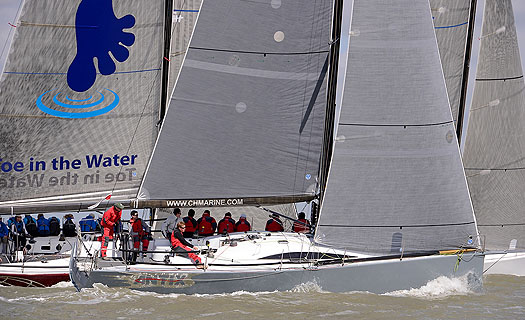
Doing the business. Anthony O'Leary's Ker 39 Antix settling into the groove on the way to the top place in the Easter IRC Championship. Photo: Rick Tomlinson
That in turn augured well for Ireland's Commodore's Cup chances, which then received a further boost last weekend when the crew of another Irish team wannabe, Quokka with Michael Boyd and Niall Dowling, had a winning weekend in the Warsash series with their temporary mount Tarka in anticipation of Quokka's return from the Caribbean at the end of May.

The Colours Match team racing between UCD and Trinity served up top sport in the Liffey, with Trinity winning. Photo: W M Nixon
Meanwhile the universities racing has been brought to life, for although UCD had a convincing win in the racing with the SailFleet J/80s to become the Irish team for the Student Yachting Worlds in France in the Autumn, before April was out the Colours Match in the Liffey under the burgee of the Royal Alfed YC, team-raced in Fireflies, saw Trinity take the honours in convincing style.
But if we're looking for something which really did set things freshly alight, it was out in Hyeres where the ISAF Championship saw the northern duo of Ryan Seaton & Matt McGovern take silver in the 49er, almost immediately moving them up the global rankings from 33 to 11, a quantum leap and no mistake.
The potential for serious success by these two has been fairly obvious for some time, but anyone who sails boats will know only too well how many factors have to come into alignment to get you up among the magic metals at the end of the day.

Stars of the silver sea – the Seaton/McGovern team took a silver medal for Ireland at Hyeres.
That their new global status was almost immediately acknowledged by this rankings improvement will in turn add heft to everything they do and say. Thus when, some time ago, the Ryan/Seaton equipe suggested that the 2016 Olympics sailing waters in Brazil are so off the standard as to be a health hazard, it attracted polite attention. But now that they're Number 11, and still counting down, much more notice is taken. And the fact that the Vice President of the International Olympic Committee has suggested, with something approaching despair, that the facilities in Brazil just aren't going to be ready for 2016 at any standard, all gives added legs to the statement from Ireland's 49er crew.
This in turn makes us wonder where world sailing might go in 2016 if the Brazilian setup is still Work in Progress. With tongue only slightly in cheek, we suggest they need look no further than West Cork, where Baltimore Sailing Club has been expanding its facilities to meet increased demand as a club which last year introduced something like 700 people to sailing. That BSC and current Mitsubishi Motors "Club of the Year" Kinsale YC further east along the West Cork coast have both been putting in premises up-grade during the past year, while other clubs have been having it tough, and just about hanging in there in some cases, surely gives pause for thought.
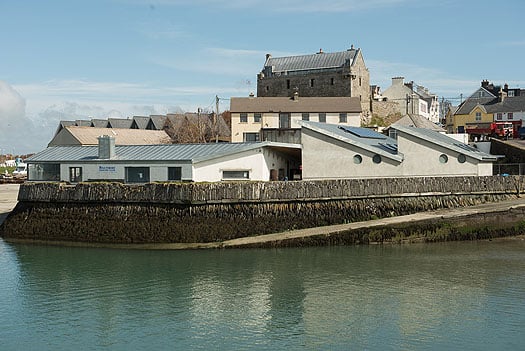
Olympic venue? The extended and up-graded Baltimore Sailing Club is ready and raring to go.
The economic shakeout of the past five years has caused a massive write-down in the value of almost all property and other assets. And in the case of yacht and sailing clubs, there has been a detailed examination of the continuing validity, or otherwise, of established yacht clubs and their traditional business model of quite high subscriptions under-writing other facilities which in turn combine to provide the complete package of an orthodox yacht club.
Inevitably, most clubs are run by officers and committee members who have been involved with the club for many years. Thus, like people who have been running a quality hotel for decades, they may have an inflated notion of what their organisation and its premises are actually worth. Admittedly there's only limited usefulness in comparing a yacht club with a hotel, but lessons can surely be learned. The fact is that hotels today are worth maybe only a third or even less of what they were reckoned to be worth six years ago. And equally, while yachts clubs certainly have a unique package to offer, is it unusual enough and special enough to charge high subscriptions when there are alternative facilities and services available?
The dilemma arises to some extent in all sailing centres. Last week we were discussing the story of the development of Howth YC. Today it is in the seemingly happy situation of having its own marina, thus it theoretically can offer an attractive all-in-one package to any potential member. But the very fact that Howth YC has done so much to help make Howth a colourful and vibrant sailing/fishing port is partly to its own disadvantage. The place has developed as a remarkable focus for top seafood restaurants. This means that the extensive club catering facilities – expected by traditional members - are constantly battling for business with a whole slew of award-winning eateries and characterful pubs nearby.
The problem is more acute in Dun Laoghaire in that the only club within the marina area is the Royal Irish YC. Thus while people may have been loyal members of the National, the Royal St George and the Dun Laoghaire Motor Yacht Club, they find that after going out in the boat, it's very easy to round out the evening aboard in the marina, chatting among themselves or with other crews on boats nearby, and then head straight for home without making their number in their home clubs at all.
This situation is less in evidence at weekends and during special events. But nevertheless it was causing such a lessening in mid-week club vitality that various steps have been taken, and the Royal St George's move to take over berths in a block booking in the outer marina, and service them by a frequent ferry direct from the clubhouse, is a visionary step.
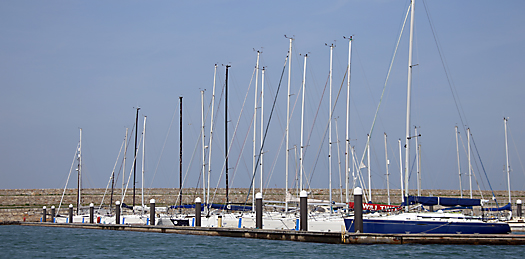
The Royal St George YC has introduced a direct ferry service from the clubhouse to its group of berths in the outer marina in Dun Laoghaire. Photo: David O'Brien
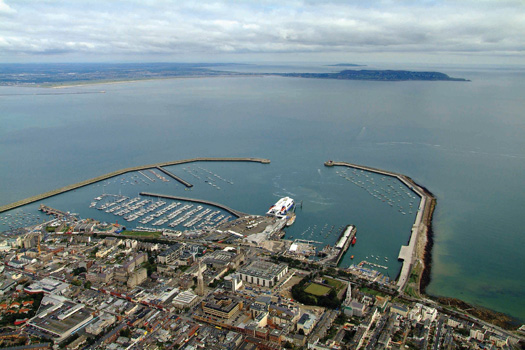
To overcome a lack of direct access to the Dun Laoghaire Marina, the Royal St George YC is running a ferry service from its clubhouse (to right of Stena Ferry, foreground) to the berths in the Outer Marina (upper left) Photo Kevin Dwyer/courtesy ICC.
Nevertheless, in all club administrations there are those who are of the opinion that, whatever the Honorary Treasurers may believe, there has to be a radical re-think of the primary subscription levels. In essence, they're suggesting that the book value of the club has to be written down such that subscriptions are halved. Personally, I haven't much of a notion of how to read a balance sheet, but the dogs in the street know that in the hospitality industry – which, in the broadest sense, is the area in which yacht and sailing clubs operate – values have been savagely slashed, and while charges may still seem high, at least the places are surviving as going concerns.
With continuing reduction in expenses across the board, one area in which there seems to be much work afoot is in the Irish Sailing Association, which in latter days had begun to seem like some hidden corner of the civil service, existing more for the benefit of staff than for the provision of services for sailors. It's amazing to learn that the ISA has sixteen fulltime staff, and a basic annual wages bill of something like €600,000. When you add in the expected benefits, it musty come in total to a very tidy yearly sum.
What on earth do they all do? While you'll invariably find the ISA logo in prominence at some top events, it has to be said that you're entirely unaware of the organisation's existence in any form at more everyday happenings, and it doesn't seem to be because they believe in doing good work by stealth. But with special study groups resulting from the major changes introduced in the ISA setup at the AGM in March, we can only hope that in time the Association will reflect the cost-cutting which has had to be introduced in the clubs, which provide the main part of the ISA's income.
While the administrative structures are rightfully being pared back in many areas of our sport, the coastal infrastructure, on which all forms of seagoing ultimately depend, continues to need maintenance and development. In this area, one very promising green shoot is the news that there are signs of movement in Dunmore East. A dredging programme is getting under way, and just this Tuesday, Minister for Marine Simon Coveney TD convened a meeting in the port to inaugurate a community approach to harbour development which, it is hoped, will help to invigorate the many places around Waterford Estuary, for which Dunmore East has the potential to be the true gateway harbour.

Dunmore East – can it fulfil its potential as the gateway leisure port for the Waterford Estuary? Photo Kevin Dwyer, courtesy ICC
In a more extreme marine environment, it has been confirmed that €6 million will be spent on improving the pier at Doolin in northwest Clare, the nearest mainland quay to the Aran Islands, which also caters for the tour boats cruising along the Cliffs of Moher. While the locals seem well pleased, I wouldn't get too excited about it. This is one very rugged part of the coast, and when you remember that it took €31 million to extend the pier at Kilronan in Inismor, the main Aran island, and another €14 million to build the little harbour at the north end of Inis Meain, the middle Aran island, then we can only hope that €6 million is going to achieve something more than a few boulders being shifted about in the roaring ocean at Doolin.

The pier at Doolin is decidedly minimalist, but it provides the shortest sea passage to the Aran Islands. Photo: W M Nixon
But then, in the west all things are possible, and along the ocean seaboard we're told that four thousand signs are being erected to guide people along the Wild Atlantic Way, the new tourism initiative using many smaller coastal roads. Quite so. Frankly, with signage at this level, it will be the Tame Atlantic Way by the time half of them are in place. I have to admit to being a complete curmudgeon in this. In many years of transitting Ireland's west coast by sea and land, one of our favourite areas while driving along the west coast has long been the coast south of Kilkee down to Loop Head, where the cliffs comfortably rival anything the vulgar Cliffs of Moher have to offer, and it is magnificently uncrowded. But not any more, if the Wild Atlantic Way movement has its way.
While I appreciate that visitor numbers have to be kept up and increased whenever and however, it has to be done in a way which appreciates that's what brings people to Ireland (rather than just to Dublin, which is a special case) is an unspoilt landscape. So, four thousand signs just for the one Atlantic Way? Ogden Nash had something to say about this:
"I think that I shall never see,
A billboard lovely as a tree.
But then, until the billboards fall,
I'll never see a tree at all".
Be that as it may, the final sign that suggests things are on the move again is a notice I spotted recently posted at a nearby club, though language pedants might wonder how a notice which manages to mangle so utterly the plural of "dinghy", even to adding a completely superfluous greengrocer's apostrophe, could be seen as encouraging in any way whatsoever.
Well, once you've overcome your opinions about the errors, the underlying message must be good news. More youngsters are evidently coming to sailing this year. And as for the spelling mistake, even that's an improvement. A year ago, the same notice board opened by referring to something called "a dingy", but this time round we have to get to the second line before finding that. And it all comes right for dinghies in the end.
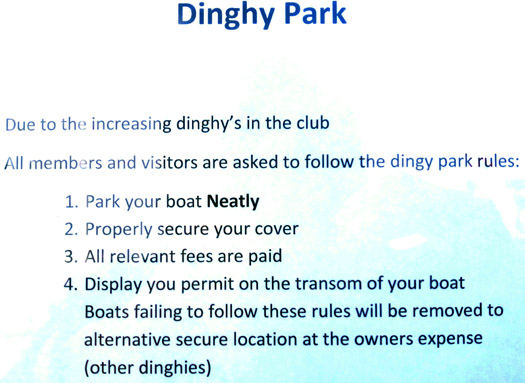
Sign of the times? Whatever about the spelling, this current notice at an Irish sailing club has an underlying message of good news. Photo: W M Nixon
Minister of Sport Appoints Royal St. George Vice–Commodore to Dun Laoghaire Harbour Company Board
#dlhc – Royal St. George Yacht Club vice–commodore Justin McKenna has been appointed to the Board of Dun Laoghaire Harbour Company. Well known yachtsman McKenna is a former chairman of the Dun Laoghaire Comnied Yacht Clubs and the current vice–chairman of the country's biggest yacht club, the Royal St. George that occupies a key location within the harbour on Dun Laoghaire's waterfront. He joins two new Board members appointed to the Board by the Minister for Transport, Tourism and Sport, Leo Varadkar TD and come into effect immediately.
The appointments are:
· Mark Finan who is a barrister-at-law with particular expertise in regulatory compliance, European and international law. He lives in Monkstown, Co Dublin.
· Justin McKenna who is a solicitor at the Dún Laoghaire-based solicitor practice, Partners at Law.
· James Jordan is a retired SIPTU trade union official and continues to be a community activist in the Dún Laoghaire area. He lives in Glenageary, Co Dublin.
The Board of Dún Laoghaire Harbour Company now comprises eight members, which is the maximum membership it can have.Speaking on the appointments, Chairperson of Dún Laoghaire Harbour Company, Eithne Scott Lennon said: "The appointment of three additional members to the Board of the Harbour Company by the Minister for Transport, Tourism and Sport, Leo Varadkar, gives us greater strength as we move into one of the most active development phases in the Harbour's history. "Following on from the Harbour Company's development plan, we are now embarking on the execution of some major infrastructural projects which will – I believe – position Dún Laoghaire as the primary leisure port facility in Ireland."
Plans include the delivery of an International Diaspora Centre on the historic Carlisle Pier, a deep cruise berth facility and a new mixed use housing and retail development. A number of initiatives to add to the leisure offerings at the Harbour have already been instigated, including the Urban Beach project, the Shackleton Exhibition and the new drive-in movie initiative which will commence later this month.
A key area of development for the Harbour Company has been the increase in cruise-calls to Dún Laoghaire in recent years, and we expect to deliver 100,000 leisure visitors and crew to Dún Laoghaire and its hinterland in 2015
Has Dun Laoghaire Lost the Plot?
#dlharbour – Dun Laoghaire's waterfront area and harbour is a hotbed of development and proposed projects. W M Nixon takes an outsider's view of what might be happening around Ireland's biggest sailing centre.
Your heart would go out to Dun Laoghaire. The perceptions which emerge from proposals for developments and new businesses along the waterfront definitely don't chime at all with the image of a place which once was known as Kingstown, and has its origins in the heights of gentility and middle class refinement.
What are we folk from other ports to make of it all? We find sailing in through the entrance to savour Dun Laoghaire harbour's unique style a wonderful experience. There is nowhere quite like it, not just in Ireland, but anywhere else in the world. Yet rumours fly around about changes which could seriously impair the special character of the place. What are those of us who may not have the inside track on the true nature of actual and anticipated developments along the waterfront to make of it all?
Not to pull the punches, it seems that the Dun Laoghaire waterfront area is going to have an enlarged halting site for the Travelling community down towards the west pier. It's going to have an "urban beach" resort amenity for the sort of people who use such places within the harbour on the inner end of the east pier, thereby blocking off a very useful berthing space. And it's going to have the Dublin area's first Wetherspoon's super-pub right bang in the middle of the harbourside.
Set against Dun Laoghaire history and the elegant appearance of its better buildings, this would all seem bad enough. But that is to ignore the most enormous elephant in the room. This is the new public library, which has been put up with astonishing speed to block out much of the sea view from the Royal Marine Hotel. It towers over the entire waterfront with a prow which suggests that at last Ireland has her first aircraft carrier. But unfortunately for any strategic purposes and rapid peace-keeping in distant parts of the world, it happens to be very landbound in the midst of mostly pleasant smaller buildings which now seem utterly dwarfed.

It's behind you!!!........ The new Dun Laoghaire library looms over everything on the waterfront. Yet if you're in the National YC (foreground) and looking out to sea, you don't know it's there. Photo: W M Nixon
It would indeed be wonderful if it were an aircraft carrier and could put to sea and leave the town to nurture something of its own true character. But instead we have to learn to live with it while wondering what it's all about, though in fairness it should be mentioned that the first notions of it were to provide a structure to match the sky-scraping Daniel Liebeskind building (remember that?) which once upon a time was planned for the Carlisle Pier just across the way.
But if this is indeed a public library, then we can only conclude that the good people of Dun Laoghaire must do an awful lot of reading, for it's HUGE. And we can only fear that if they read with the assiduity this building suggests, then they'll have neither time nor energy for anything else, not even the seagoing pursuits which the possession of one of the finest artificial harbours in the world should encourage.
From Dun Laoghaire's traditional promenading area of the East Pier, the new library building towers in particular over the National Yacht Club. Of course, if you're in that most hospitable club and looking out to sea, you're blissfully unaware of this enormous presence behind you. But the effect on people coming in from seaward is distinctly oppressive - it's like that giant black space craft which hovered over New York in the movie Independence Day.

Dun Laoghaire in the rare ould times, when you'd a real sea view from the Royal Marine Hotel, and from the pier could admire that splendid establishment in all its glory. Photo courtesy NYC.
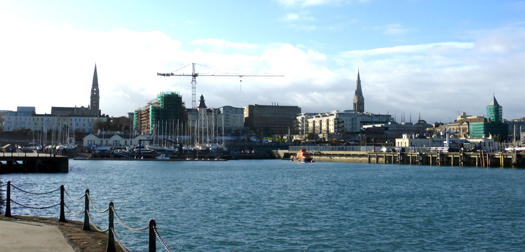
The same section of waterfront today. Is this progress? Photo: W M Nixon
Until this thing appeared, there were still some relics of ould decency and architectural harmony along the Dun Laoghaire waterfront and the streets immediately behind it. Any significant building is a statement in itself, so we're entitled to look at buildings as they are, and respond to them. The central gem of the waterfront is the railway station, designed by John Skipton Mulvany. It's a perfect little jewel of neo-classical design, and to my mind makes a much pleasanter architectural statement than that other exercise in classical work, the Casino at Marino, which was fussily built as an architectural exercise, whereas Dun Laoghaire station is both functional and beautiful, well fulfilling its contemporary role as a stylish restaurant.
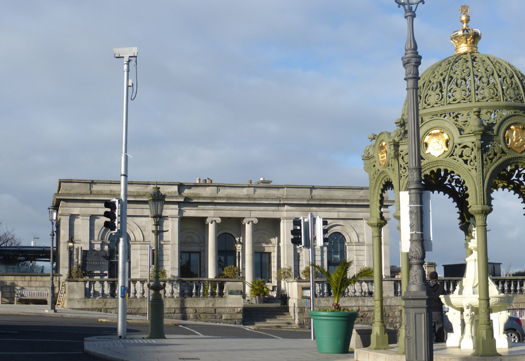
Dun Laoghaire's Mulvany-designed station is a gem. Photo: W M Nixon
Dun Laoghaire did very well out of John Skipton Mulvany, as in 1851 he created the design for the Royal Irish Yacht Club building. In terms of Irish history, few buildings are so significant in the very fact and timing of their construction. Originally founded in 1831, the Royal Irish had been overshadowed by its brasher younger sister, the Royal St George YC founded 1838. While the George developed rapidly as the exclusive preserve of the land-owning classes and the most prosperous Protestant business magnates – the offspring of Cromwellian land-grabbers and the Jamesons and Guinnesses, in other words – the RIYC, as a club with some of the older traditions in its makeup, went into a decline which was accelerated by the grievous effects of the Great Famine from 1845 onwards.
Thus when a meeting of several RIYC members – their numbers including Daniel O'Connell the Liberator - was held in a Dublin hotel on 4th July 1846 (American Independence Day by design, one presumes), it was in the hope that the club could be revived as an expression of faith in the future, and they agreed that a new landmark building on the waterfront would be the key to this.
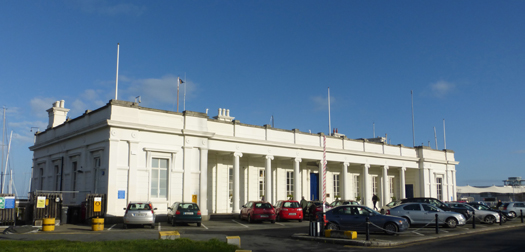
The landward side of the Royal Irish YC. With the undeveloped nature of the waterfront, the architect had to design a building which presented a proper facade on all fronts. Photo W M Nixon
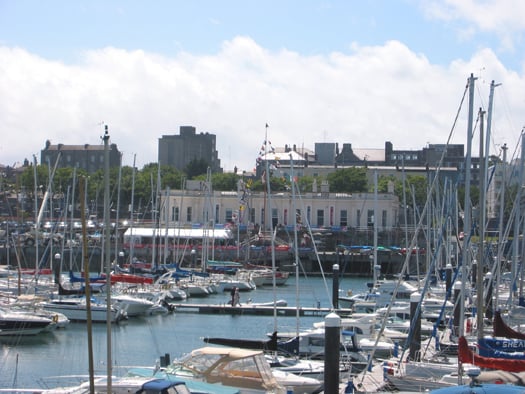
The Royal Irish YC seen across the marina. Built 1851, it is the world's oldest complete purpose-designed yacht club building. Photo: W M Nixon
So in responding to the RIYC's impressive neo-classical pavilion on the harbour, we are looking at both the world's first complete purpose-built yacht club house, and the very symbol of a nation beginning the long road to recovery from both the Famine and centuries of conquest and despoliation.
Along the waterfront, the Royal St George clubhouse by contrast was built through frequent expansions, but as Mulvany was also involved in some of the stages, it has a fine sense of completeness despite its several creators in different eras. Facing up to the challenge of matching these two classical buildings on the waterfront to the west was clearly an insuperable task, so when the National Yacht Club came into being as the Edward Yacht Club in 1870, it went for a much more under-stated architectural style. There's something attractively of the shooting and fishing lodge of the west of Ireland about it, it seems modest by comparison with the other two clubhouses, yet it's surprisingly roomy and stylish within.

Although it was built in several stages, today the Royal St George YC presents a complete appearance, and it preserves its sense of identity despite the encroachment of much taller modern buildings nearby. Photo: David O'Brien
All three of the big waterfront clubhouses are immaculately maintained and each brings its own injection of vitality – and substantial employment – to Dun Laoghaire. And the town in turn has developed in concert with the growth of maritime activity, and the increased communication with Dublin brought about by the historic railway (which was opened in 1834) and frequent road improvements, while summertime excursion steamers sailed to the harbour from Dublin port.
Some would compare the stylish seaside town for Dublin which tried to develop at Dun Laoghaire with Brighton in its relationship with London. But Brighton was purely a seaside resort in which the recent marina is an add-on, it's not a harbour which is central to the place. Dun Laoghaire by contrast is all about the harbour. There was virtually nothing there until this vast asylum and ferry harbour for large vessels (that was its sole original purpose) was built on a totally empty bit of coastline eastward of the old Dunleary harbour, a shallow tidal inlet which it enclosed and whose existence is remembered in the area's local name The Gut.
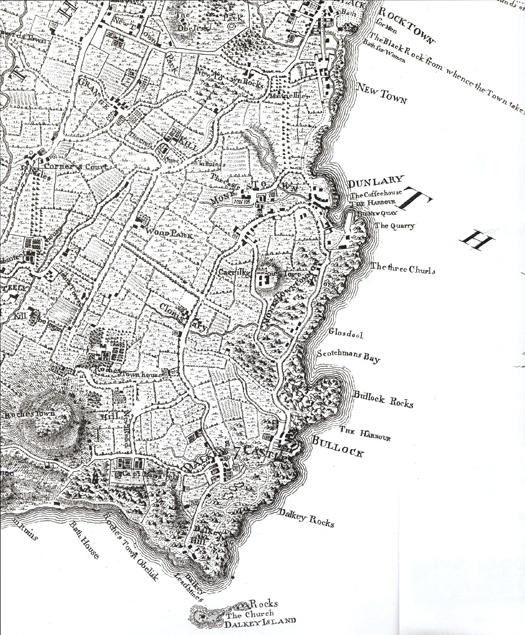
The coast at Dun Laoghaire before the harbour was built. The harbour of Old Dunleary, in the area still known as The Gut, was a shallow creek in the southwest corner of the new harbour.

First plan for the new harbour in 1817. The entrance was made wider in the finished version, and the West Pier was built further west to enclose the Old Dunleary harbour
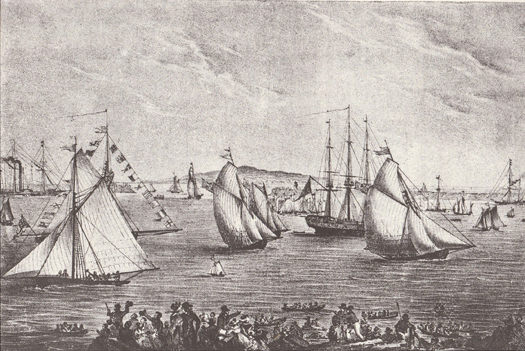
The first regatta in the new harbour was sailed on July 22nd 1828, and was won by Liberty (on right, 39 tons, owner Lord Errol) from Medora (45 tons, owner Mr Kelly). The Royal Irish YC emerged in 1831 from this event.

The yachtsman's Dun Laoghaire today, as shown in the ICC Sailing Directions. Courtesy Irish Cruising Club
Thus it may be stretching it a bit, but the most telling comparison for Dun Laoghaire's aspirations might well be Trieste on the Adriatic. In the glory days of the Austro-Hungarian Empire, Trieste was Vienna-on-Sea. The distance from the capital may have been enormous by comparison with the short hop from Dublin out to Dun Laoghaire. But Emperors – even ancient Hapsburg ones – could move mountains and shorten apparent distance, and they could ensure that the distance to Trieste was no barrier to the place having a Viennese atmosphere, style and sense of place.
Those who find such an idea crazy might like to remember that your man Von Trapp, he of Sound of Music fame, was in real life an officer in the post–imperial Austrian Navy. Trieste was for real. So in a sense if we wanted to see what Dun Laoghaire in its burgeoning Kingstown days was trying to become, just think of it as Official & Ceremonial Dublin-on-Sea. Thus the buildings tried to be slightly miniaturised versions of impressive buildings of government in the city itself, and for a while they succeeded.

The Town Hall gets the attention it deserves. Photo: W M Nixon
The Town Hall, for instance, is a delight – to me it speaks as a restrained exercise in Italianate Victorian, and were it facing onto a proper town square, we really would have a space to celebrate. And just along from it in the town in its glory days was the unsullied façade of the Royal Marine Hotel. French chateau, I would say, and all the better for it. But another enjoyer of architecture was suggesting the other night that there was more than a hint of the south German schloss in it, so we agreed that it was either French or German depending on which country had won the most recent little war over Alsace and Lorraine.
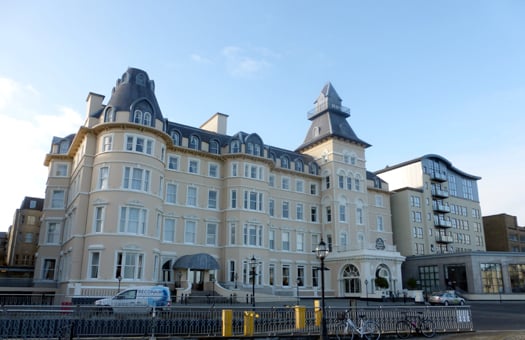
The Royal Marine Hotel has a distinctive style which unfortunately was not replicated in the extension on the right, which was added several decades ago. Photo: W M Nixon
Whatever, the Dun Laoghaire waterfront at the height of the late Victorian-Edwardian era really was quite something. There were several different styles of architecture, but mostly they were good examples of their type, and all respected each other. It had a sense of completeness which harmonised with the harbour. But since then we seem to have lost the plot. Is there an element of disliking the built symbols of the past, and therefore sticking up something which is effectively a deliberate affront?
Perhaps it's just that architects are scared stiff of being accused of producing new buildings, or extensions to buildings, which are merely pastiches of what went before, despite the fact that the general public seem more than happy with a good pastiche. And surely it's better to have a good pastiche than a bad bit of pseudo-modern design which clashes with everything about it?
Thus the harmonious Dun Laoghaire waterfront of a century ago, as seen from within the harbour or down the piers, is now giving out conflicting messages which dampen the sense of welcome for those entering the port. The stately Royal Marine Hotel, a bit pretentious in its day perhaps, but nevertheless true to itself, was given an addition on its western side which, unusually, still hasn't mellowed in – it continues to look like a bad example of architecture from a particularly poor period.
As for that wonderful Town Hall, the office block added down one side is better than the addition to the Royal Marine, but it has lost the opportunity to make a statement of harmony on the building's north side facing across to the railway station. And as for what could have been a town square in front of the Town Hall (for which we argued in favour in several issues of Afloat magazine a very long time ago) that was filled with the Pavilion Development which, while built with quality materials, has never seemed to quite know what it is supposed to be doing. You could scarcely claim it to be a runaway commercial success, and as ever in Dublin, it was the residential part of the project which provided the real motor for the exercise.
But those residential blocks in turn intruded on the vital miniature parkland and garden in front of the Royal Marine Hotel. Now that glorious sea view from the Royal Marine is being further impaired by the new library. In fact, "impaired" is scarcely the word. The Royal Marine doesn't really have a sea view any more at all, in the sense that rooms at the front had a view clear out into the open waters of St George's Channel. Strictly speaking, all that the Royal Marine can now look forward to is a harbour and bay view, which is rather different. Much better than many Dublin hotels, perhaps, but a poor thing by comparison with the wide nautical vistas of the past.

Artists's computerised impression of how the view of the Royal Marine hotel will look once the new library (left) is completed
As for this new library, doubtless in the architectural trade it will be seen as an impressive use of new materials, and it will be pointed out how skilfully it has been fitted into a narrow space. But the computer-generated impressions of the finished building show something a little too like a Belfast peace wall to bring joy to the heart, and on its east side – the hidden side looming over many residential properties – they seem to be utilising rather a lot of nasty red brick, something which is otherwise almost entirely unused anywhere else on the Dun Laoghaire waterfront.
But while the new library may seem to roar at its neighbours and loom threateningly over them, not every new development along the Dun Laoghaire waterfront provokes hostility. For instance, the new Irish lights headquarters is so good of its type that it greatly enhances the area. And as for the Ferry Terminal, "reasonably good of its sort" might be the kindest response. Something had to be provided to give a positive architectural response to the very new-style HSS ferries, and when there's one in port it's sometimes difficult to tell where ship ends and ferry terminal begins, which is as it should be.
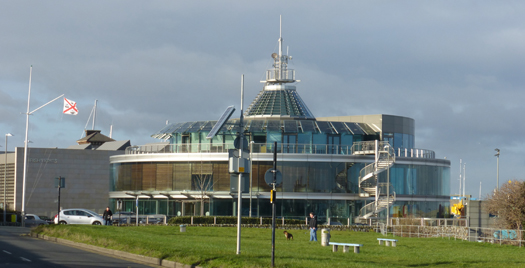
It just shows what you can do by really trying, and being brave. The impressive Irish Lights headquarters building. Photo: W M Nixon
But the era of very high speed ferries may be drawing to a close, as the shipping companies gravitate towards a new generation of ships which may not be so utterly fast, but are much quicker than the boats the HSS replaced, and provide a level of on-board comfort which makes the little extra time aboard slip easily by.
With economy measures now totally dominant, the lower berthing prices and much greater available berthing options offered by Dublin Port offset the fact the driving through the hinterland of the Port to the ferry terminals is not really a joyous urban experience. Most car-ferry passengers are prepared to tolerate a level of urban and sub-industrial blight in order to get cheap fares and frequency of service.
But where the ferries move away as they appear to be doing from Dun Laoghaire, it seems the cruise liners want to move in. The cruise liners currently can berth alongside in Dublin Port, but have to lie off in Dublin Bay if they want to send their passengers directly by tender into Dun Laoghaire. But for the cruise liners and their guests, the prospect of Dun Laoghaire becoming a proper cruise liner port is positively mouth-watering.
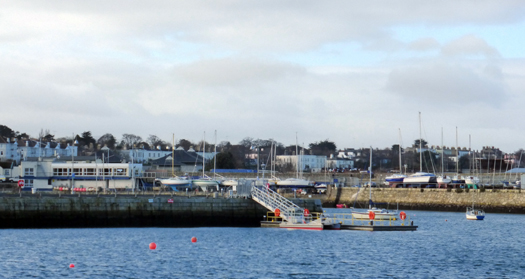
At the moment, the only access the passengers on large cruise liners have to Dun Laoghaire is via the ship's tenders to this landing pontoon in the Inner Harbour. Photo: W M Nixon
For when it fulfils its potential, Dun Laoghaire is a place of style and fun, an ideal up-market cruise liner destination. Simply being there in a luxurious cruise liner would be enough in itself on a sunny day with the harbour and waterfront alive with people enjoying themselves. And the ready access to Dublin itself, and the Garden of Ireland in Wicklow, is all a bonus.
But such perfection won't come cheap. For sure, if it comes to fruition the Dun Laoghaire Harbour Masterplan of two years ago, indicating a large cruise liner berth to the west of the present ferry terminal, would indeed provide the Harbour Company with a golden source of income. But whether that income can be transferred onwards to traders in the town is another matter.
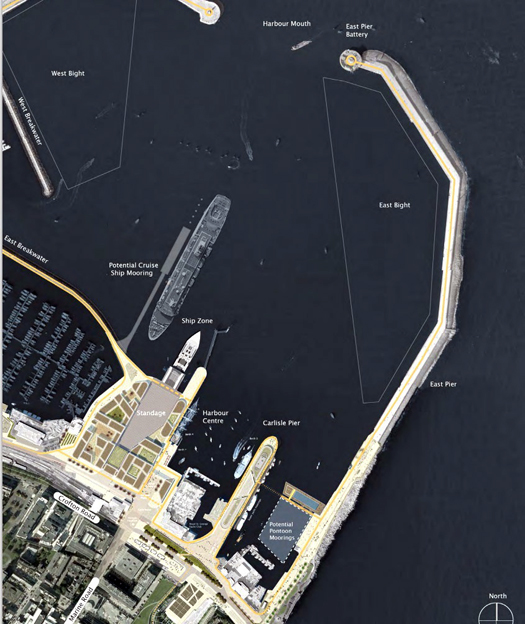
The initial plan of two years ago for a Cruise Liner berth within Dun Laoghaire Harbour. While it will restrict some sailing and boating space within the harboiur, new space will be created by the removal of the moorings in the East Pier bight. Note the proposed swimming pool indicated at the time at right angles to the East Pier off the National YC (bottom right) with marina berths within a new breakwater.
Cruise liner passengers are notorious for seeking complete packages beforehand. Thus when they arrive in port they expect shore visits to be part of the deal, and they prefer to move in pre-paid groups ashore, rather than move individually and spend some money in the town. So those who would expect across-the-board benefit may be disappointed. They may find that the cruise liner seen as the goose that lays the golden does indeed squat down, almost taking over the entire harbour, and it does indeed lay a golden egg. But that golden egg is only a fat berthing fee for the harbour company and hire fees for some bus company. Beyond that, expenditure can very limited.
Yet there's no denying the real money that be made out of berthing fees, and that of course will percolate into the town in the form of wages for extra waterfront staff. Who knows, they may even have to find a crew for a designated Dun Laoghaire harbour tug or two, though a state-of-the-art cruise liner is computer controlled by a single joystick activating thrusters working every which way, and it's amazing the spaces they can access without tugboat aid. That said, in the event of a rare summertime nor'east gale, you could sell tickets for the end of the pier to watch a giant liner getting out.
But this is all way in the future, though with every step in the economic recovery, that future is accelerating in its approach. For the moment, we can be sure that markers are being put down for future harbour use, and the word is that all the swinging moorings in the east bight of the harbour are going to be cleared, presumably to allow eventual manoeuvring space within that part of the harbour for liners. As that space will be empty when no liner is moving, its possible availability will partly compensate for the inevitable loss of sailing and boating space within the harbour, which is a proper concern of Water Wag sailors, inshore rowing clubs, and the increasing number of sailing schools.
A newer line on the grapevine has it that one of the yacht clubs outside the current marina, currently concerned about members losing those mooring in the eastern bight, has negotiated exclusive rights for its members to the stand-alone marina pontoons in the northwest part of the harbour inside the northern marina breakwater, those berths to be accessed by a regular ferry service from the club in question.
While seeing the logic of this, it would put paid to a crazy little notion of mine. Until this new allocation arose, it had seemed to me that there was potential for a completely new club, with its headquarters way down the West Pier where it meets outer marina breakwater. This new club would have its own direct access to that northwest part of the marina. The wild West Pier – which some would like to se as a kind of nature reserve – has ample room for both a roadway to this new clubhouse, and the existing walkway right out to the lighthouse. It would be one of the few clubs in Ireland to be south-facing, and its location would certainly provide that sense of being away from it all which is supposed to be what going sailing is all about.
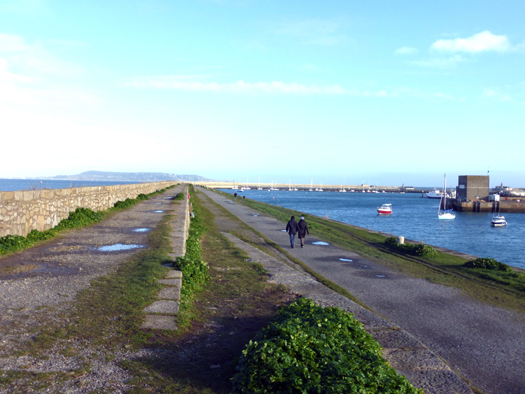
The wild West Pier. Were it needed, there is plenty of space for both a walkway and a roadway. Photo: W M Nixon
But that little daydream is now gone with the likelihood of a rapid ferry service from a club to the northwest Marina pontoons. Meanwhile, back in the real world, what is happening to preserve or destroy Dun Laoghaire's unique ambience which will, it's hoped, encourage Cruise Liner Companies to fork out mega-bucks to berth there?
If you look carefully at the Masterplan, you'll see that in front of the National YC there's a blue pool indicated at right angles to the East Pier. At the time, this was envisaged as a swimming pool and lido area in a vast barge, and it seemed a reasonable idea, as within it there were indicated new marina berths within convenient reach of the club.
But a recent planning application by the Harbour Company has put a different spin on all this. The new "urban beach" will be on a floating structure paralleling the East Pier alongside that handy berthing area on the East Pier. A cost of €2.5 million is being quoted as the capital expenditure needed to create this new facility, and the spokesmen for the harbour company are confident it will attract enough high-paying customers to pay off the initial cost while covering the significant running costs.
That's as may be, but this large intrusion into valuable berthing space is also a matter of concern for those who have been campaigning long and hard for the restoration of the nearby disused Dun Laoghaire Baths, which are outside the harbour area and therefore wouldn't reduce any valuable berthing space. But in any case they're in a deplorable state of dilapidation, a danger and an eyesore, so some action is urgently needed. There's a Public Meeting on today (Saturday January 25th) about all this in the Kingston Hotel in Dun Laoghaire at 3.0pm, and it will be interesting to hear what people think about the old baths in relation to the proposed new urban beach.
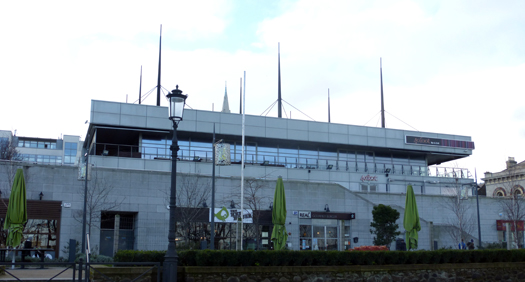
The English pub chain J D Wetherspoon have indicated their intention of opening in the former Forty Foot premises on the top of the Pavilion. Photo: W M Nixon
We move along the waterfront to the Pavilion, and the former Forty Foot pub. It's as near as certain going to be the Dublin area's first J D Wetherspoon pub. You'll have heard of them as the people in England who already have a chain of 900 pubs, and have just opened the first ever pub at motorway service area, which one would have thought unthinkable, but such seems to be the case. Anyway, big chief Tim Martin and his efficient team running this outfit have decided the time is now ripe to move into Ireland with its many post-Tiger era bankrupted bars.
And they make no secret of their intentions. Their ideal location, they say, is large premises in a strongly working class area. Good for them, you say, but who on earth reckons Dun Laoghaire to be a strongly working class area? Well, 900 successful pubs across England can't be wrong. And it could well be what the Pavilion needs to come to life, even if it's not quite what posh passengers on a cruise liner might expect. But as for resentment that an English pub chain is moving into Ireland, the reality is that your favourite local, after a tricky time emerging from the aftermath of the boom years, is now probably owned by a German bank anyway.
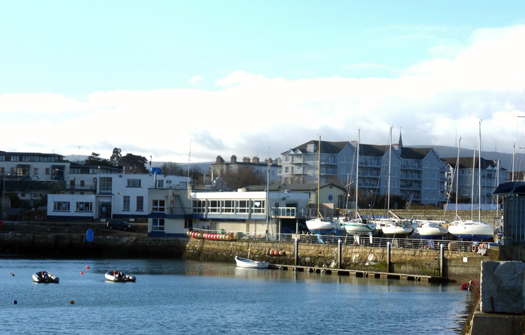
It's one very crowded little spot already. The Dun Laoghaire Motor Yacht Club, the Coastguard, and the Irish National Sailing School are among those crowded into the southwest corner of the harbour where a new Halting Site is also planned. Photo: W M Nixon
Concluding with our third opening point, the proposed new halting site towards the West Pier is a tricky one. That corner of the harbour has a small long-established site, presumably the new one will be much bigger. And things are already very crowded down there with the Dun Laoghaire Motor Yacht Club on the sea side of the little quayside street, and the premises of the Irish National Sailing School, the Irish Coastguard and others across the narrow road.
The business of Traveller Halting Sites is a difficult one, but doubtless Dun Laoghaire can cope in its own way. After all, the harbour area already has several locations which look after the needs of people who have immediate access to unexpectedly large sums of ready money, people who also have a strange taste for drinking alcohol in the open air even when the weather is atrocious, people moreover who enjoy moving about all the time in uncomfortably confined damp spaces in close proximity with like-minded ruddy-faced folk. It's just that they're not called Halting Sites. They're called Yacht Clubs.
Dun Laoghaire Harbour Company CEO Gerry Dunne responds to this article here.
Royal St. George Celebrate 175 Years of Champions
#rstgyc – A full club house of 250 sailors raised their glasses to a roll call of 175 years of sailing achievements at the Royal St. George Yacht Club this evening in Dun Laoghaire as Ireland's biggest yacht club toasted over 600 international titles. See photos below.
The champions were saluted by international yachting writers and guests of honour Bob Fisher and Afloat.ie's WM Nixon who gave a history of the Royal St. George Yacht Club achievements and a presentation on the very latest from the Americ's Cup.
The awards shared by 255 members include 322 Irish National Champions. Tonight's champion's dinner included 10 Olympians, the club has been represented at all Olympic Games but four since the first Irish participation in 1948. Ireland's only Olympic sailing medallist, Silver medallist David Wilkins from Moscow 1980, was also in attendance.
Royal St. George sailors have also won the Irish Helmsman Champions 30 times with 19 champions.
14 attended tonight's dinner. Round the World Racers Angela Heath & Damian Foxall). In Cruising, awards include circumnavigators of the globe Peyer and Susan Gray and Pete Hogan.
Epic Passages by Paddy Barry and Michael Holland and many transatlantic/transarc passages were also saluted.

Members of the Royal St George Yacht Club who have won the ISA Helmsmans Championship Back Row (l to r): Robin Hennessey, Vincent Delaney, Johnny Ross-Murphy, Brian Craig, Peter Bayly Front Row (l to r): Neil Hegarty, Sean Craig, Tom FitzPatrick, Adrian Bell, Stephan Hyde, Gerald 'Gerbil' Owens, Chris Arrowsmith, Matthew O'Dowd, Commodore Liam O'Rourke. Photo: Gareth Craig

Members of the Royal St George Yacht Club who have represented Ireland in the Olympic Regatta Back Row (l to r): Peter Grey, Robin Hennessy, David Wilkins, Commodore Liam O'Rourke Front Row (l to r) Barry O'Niell, Tom FitzPatrick, Derek Jago, Gerald 'Gerbil' Owens Photo: Gareth Craig
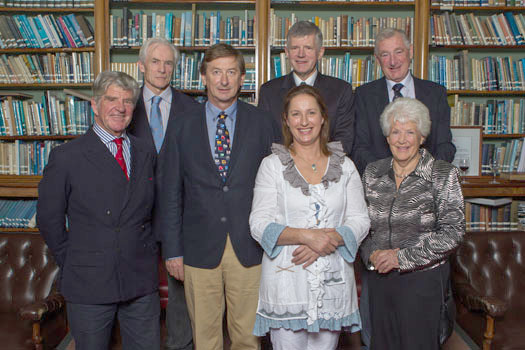
Members of the Royal St George Yacht Club who have circumnavigated the globe, or undertaken other significant cruising achievements: Back Row (l to r) Peter Hogan, Rod Cudmore, Peter Grey Front Row (l to r) Keith Hunt, Michael Holand, Angela Heath, Susan Grey, Commodore Liam O'Rourke Photo: Gareth Craig
All Sailing Super Stars, By George
#rsgyc – The word on the grapevine is that the Royal St George Yacht Club, currently the Mitsubishi Motors "Sailing Club of the Year", is planning a special festive event to celebrate its 175th birthday. The whisper is that it will be a gathering to honour those members who have won major events and titles right up to and including Olympic medals.
We've been allowed a glimpse of the list, and it's very impressive. Which is what you'd expect from a club which has shown an extraordinary ability to adapt successfully to changing circumstances, while displaying a special talent for recruiting promising sailors from all round the country when they come to Dublin, either to go to college or to work.
Yet even as they keep a weather eye open for potential members who will give as much to the club as it will give to them, the club's administrators never lose sight of their past. And what a past it has been. Like many great clubs, it started modestly enough around 1838 as the Pembroke Rowing Club in south Dublin. But the oarsmen of the Dodder soon reckoned that the cleaner waters of the new harbour out on Dublin Bay, where Dunleary had recently been re-named Kingstown, would provide more pleasant conditions than the fetid Liffey.
As for their sport, several key members were thinking of moving into slightly larger craft, driven by sail. Suddenly, the new club took off. Boat sizes and numbers increased exponentially, the membership became rather grand and extremely wealthy, and by the 1850s the little rowing club had morphed into the Royal St George Yacht Club, with handsome and frequently extended premises on the waterfront, and a membership list which seemed to include just about every great landowner in Ireland who had the slightest interest in the rapidly growing sport of yachting.
In looking back from the present day, we tend to think that the modern emphasis on active participation is just that – a modern thing. Indeed, it's said that it was a member of the George, when it was at the height of its affluence, who occasioned the apocryphal story which captures the sprit of certain yacht owners at a time when most wealth was concentrated in very few hands. Cue to stately home somewhere in Ireland:
The Butler waits upon his lordship, and clears his throat in a meaningful manner.
His Lordship: "Yes, James".
Butler: "My Lord, I have just been in conversation with our land agent".
HL: "Indeed".
Butler: "And he tells me that we are living in financially stringent times".
HL: "Is that so?"
Butler: "Such seems to be the case, my Lord. In fact, the agent tells me that we may have to implement some cutbacks in the usual expenditure".
HL: "Nothing too severe, I trust".
Butler: "Well, my lord, I'm afraid the agent thinks that we may have to sell the yacht"
HL: "Sell the yacht?"
Butler: "Regrettably so, my Lord".
HL " Good heavens. D'you know what, James? I didn't know we had a yacht. Well, I do declare. Isn't life just full of surprises? I'll need to think about this".
But while there were George members who shaded towards this approach to yachting, there were others who really did sail the seas. One of the original Pembroke men, William Potts, had moved up from rowing to serious seagoing with the substantial new cutter Caprice, and in 1850 he cruised to Iceland.
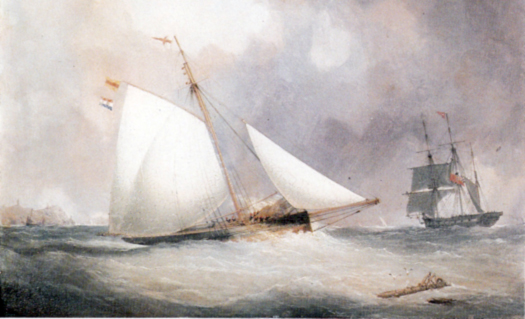
The cutter Caprice in which William Potts, a founder member of the Royal St George YC in 1838, cruised to Iceland in 1850.
As for the racing side of things, we have to remember that this was still in its infancy in terms of organisation even if Lough Erne YC had been formed in Fermanagh as long ago as 1820 specifically to run yacht races, and thus records of early sailing events are often incomplete and inconclusive. After all, the George had already been in existence for a dozen years when the schooner America won that famous race round the Isle of Wight in 1851, but the fact that it was a scratch event which took no account whatever of different yacht sizes in collating results shows indicates the relatively primitive site of the sport of yacht racing at the time.
But the rapid increase in wealth in the latter half of the 19th century meant that the development of yachting, and its regulation, accelerated markedly. In Ireland, it was in Belfast that economic growth became most rapid, and the new wealth accumulators from the north were keen to get involved. The Ulster Yacht Club did not get founded until 1866, and it became the Royal Ulster YC in 1869. But meanwhile one of the richest and most energetic of the new Belfast linen magnates, John Mulholland who later became Lord Dunleath in 1892, had been spreading his sailing wings as a member of the Royal St George.
By the 1860s, schooner racing was the apex of the sport, and in 1865 Mulholland commissioned the 153-ton schooner Egeria from the top designer-builder of the time, Wanhill of Poole. At just under 100ft LOA, the beautiful new vessel soon became known as "the wonderful Egeria", and for more than a decade she was the winner par excellence with more than sixty major trophies to her credit, while her owner was so fond of the boat that he kept her for many years after she had been out-classed as a racer.
In Egeria's competitive years, Mulholland was no absentee yacht owner. On the contrary, he seems to have been the Denis Doyle, the Piet Vroon, of his day, enthusiastically racing his lovely ship with a crew of 12 wherever there was good competition to be had. He embodied the best of the sporting instincts among the active yacht owners in the George, which had been a leading club in supporting the idea of "flying starts".
This marked a change from the early days of yacht racing, where the starting gun was fired with all competitors lying to their anchors. A flying start under full sail across an imaginary line was much more fun, and in Dun Laoghaire harbour it could be extremely sporty when the big yachts got crowded. As for the finishes, they were recorded by the naval officer/marine artist Richard Brydges Beechey, so we have a fair idea of what they could be like, but the image is augmented by an account of "the famous Egeria" making an in-harbour finish under full sail to win: "....what a fright the Egeria gave the multitude of yachts lying at their moorings when, on returning to Kingstown harbour she, on rounding the buoy, had so much way on that she absolutely ran through the crowd of yachts. The escape of many craft was little short of marvellous...."

A cutter finishing in the harbour at the Royal St George Regatta, 1871, as recorded by Richard Brydges Beechey. The larger schooner at anchor on left may be Egeria
By the time Beechey was recording the scene, cutters had taken over from schooners as the premier racing class, but here too the Royal St George was to set the pace with John Jameson and his legendary Irex. The Jameson family had been moderately prosperous whiskey distillers in Dublin since 1780, but in 1864 phylloxera wiped out the vines in the brandy districts of France. With brandy supplies dwindling, Irish whiskey and soda soon became such a fashionable drink internationally that the entire Jameson family entered the ranks of the mega-rich.

John Jameson's 1884-built cutter Irex was the most successful racing yacht of her era. She is seen here after winning the annual regatta of the Royal Harwich YC on England's east coast
John Jameson himself, while an extremely able businessman and talented sailor, was personally rather shy. However, his younger brother Willie was anything but, and the Jameson brothers with the 1884-built Irex were enthusiastic campaigners on all coasts with John the backroom boy, while Willie was front of house. And the fact that every time Irex won a regatta, the name John Jameson appeared in the newspapers was no harm at all for their whiskey sales. Then at Cowes Week after a spectacular race in heavy weather in which the Irex won by half a boatslength, as the brothers were anchoring afterwards, the rowing gig from the royal yacht arrived alongside and a written message was passed on board: "The Prince of Wales compliments and congratulations. His Royal Highness would be very pleased if Mr Jameson could join him for drinks before dinner".
John Jameson became hyper-shy, and said to Willie he couldn't be dealing with a situation like that at all. But Willie said not to worry, he was Mr Jameson too. So off he went to the party and got on so well he stayed to dinner. And when the Prince of Wales was planning the building of the superb Watson cutter Britannia a few years later, he asked Willie to be owner's representative during the building and commissioning, and subsequent racing.

The day Britannia came to call. The new royal cutter Britannia in Dun Laoghaire harbour in 1893 on her delivery voyage from the Clyde to the Solent, "and Mr Willie Jameson was seen on board". Note that a boomless gaff trisail is set instead of the full main.
Needless to say, nobody really believed it back in Dublin, so when the brand new Britannia was being sailed south to the Solent from the Clyde in 1893, Willie Jameson made damned sure she called to Dublin Bay, and the local papers duly reported that "Mr Willie Jameson was indeed seen on board". But while he was a great man for a party, Willie could be cussed enough. When the Britannia was being scuttled in 1936 in accordance with the recently-deceased George V's will, the Royal Family sent Willie Jameson her steering wheel as a memento of his time on board in a key role. But he promptly sent it back with a curt note saying that when he sailed the Britannia, she was tiller steered....
The Jameson standing in sailing was such that when Lord Dunraven decided it was time he took up sailing in the mid-1880s, it was as a member of the Royal St George and aboard Irex that he got his first taste of the sport, an experience which followed with his two increasingly acrimonious America's Cup challenges in the 1890s which, mercifully for the George, were made through the Royal Yacht Squadron to which the County Limerick peer had transferred his allegiances.
Back in Dublin Bay meanwhile, it was a very active and successful Royal St George sailing member, wine merchant George Black Thompson, who was one of the sailing men involved in codifying yacht racing through the Royal Alfred YC's pioneering work. But G B Thompson was primarily a George man, and just as it is with the club nowadays, he was keen to encourage promising newcomers. Thus in 1892 when his 5 Rater Shulah was becoming out-classed competitively but had the ability to become a fast cruiser, he was more than happy to sell her to two young brothers who had been teaching themselves to sail with a Water Wag dinghy up on Lough Dan in the Wicklow mountains, and now wanted to cruise.

G B Thompson, a leading member of the Royal St George YC for many years, introduced Erskine Childers to the possibilities of cruising in 1892. He succeeded Lord Dunleath as Vice Commodore in 1895.
Shulah's new owners were Erskine and Henry Childers. They soon took Shulah away from Dublin Bay with a cruise to the west of Scotland, where they laid the boat up and cruised the Hebrides again the following summer. After that, Erskine Childers began his career in London. He decided Shulah was too deep for his new cruising area in the Thames Estuary, and acquired the Vixen which, after a cruise to the Friesian islands and the Baltic, became the fictional Dulcibella, "heroine" of his best-seller novel Riddle of the Sands.
Published in 1903, the Riddle of the Sands hinted at the possibility of war between Germany and Britain, which duly came in 1914. But at the same time many of the Royal St George members were facing their own problems with the breaking up of Ireland's largest estates under the Land Acts. That and the Easter Rising of 1916 and the establishment of the Irish Fee State in 1922 meant that in the space of just three decades, the club had gone from affluence to a relatively sparse existence.
Yet somehow it adapted, and in time the club was back in the forefront of sailing in an Ireland which may have seemed changed. But was it really? As a member of the new Free State Government put it, "we are the most conservative revolutionaries ever seen". So, far from the relics of ould decency like the old royal yacht clubs being wiped out, in time they began to thrive again, and by the mid-1930s the George was extending its forecourt to accommodate sailing dinghies such as the Water Wags, while members also were involved in forming the new 17ft Mermaid class
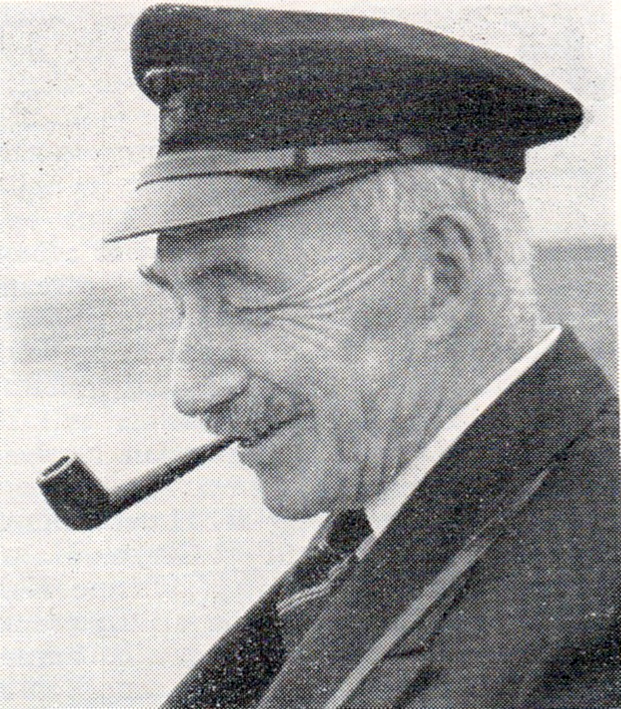
Billy Mooney, who had sailed from Howth between 1919 and 1943, then moved to live in Sandycove and became very active in the Royal St George, of which he had already been a member for many years. A founder member of the Irish Cruising Club, he is seen here at the age of 74 when he was still to be seen sailing as a member of the George squad in Firefly Team racing, another area of sailing in which the club played a pioneering role.
As World War II ended in 1945 and international sailing resumed, the club was right in there, with a leading member, Billy Mooney, winning his class in the 1947 Fastnet with his 43ft ketch Aideen. The Mooney family – Billy and his son Jimmy - were a formidable force in sailing, and were also in the forefront of the establishment of the Irish Dinghy Racing Association. It was a fellow dinghy enthusiast, Douglas Heard, who was to become the first "commoner" to be Commodore of the Royal St George, succeeding the Earl of Iveagh, one of the Guinness family, in 1960.
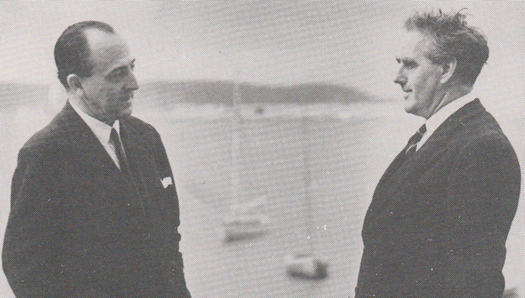
Douglas Heard (left) and designer Uffa Fox discussing the new Huff of Arklow on the club veranda in 1950

Well ahead of her time. Douglas Heard's Flying Thirty Huff of Arklow, designed by Uffa Fox and built by Jack Tyrrell, incorporated design features which were not generally adopted in offshore racing boats for another thirty-five years. Photo: W M Nixon
There was of course nothing common about Douglas Heard, who somehow found time to record the Irish sailing and boating scene on film while at the same time being an active participant, as his interests encompassed just about every branch of sea sailing, while his passions included the preservation and restoration of Ireland's inland waterways. Offshore racing and distance cruising were among his activities, and in 1950 he had his friend the innovative designer Uffa Fox create the plans for a Flying Thirty racer/cruiser. In effect a double size Flying Fifteen, this very advanced boat was built by Jack Tyrrell in Arklow, and though she was so far ahead of her time as to inevitably have weaknesses on some point of sailing, off the wind she was unbeatable while her seagoing credentials were amply demonstrated by cruises to Iceland and the Azores.

Three stages of development in the Royal St George YC premises. The clubhouse (right) in the 1880s. when there was much more in the way of green spaces on the Dun Laoghaire waterfront.......

.....and in 1934 shortly before the forecourt was extended to provide improved dinghy space and better access to deep water....

......and the Royal St George Yacht Club today, providing full facilities for all branches of sailing. Photo: David O'Brien
In compiling the first provisional list of the George's significant sailing award winners which currently goes back only to 1946, the organisers of the upcoming 175th Anniversary celebrations have produced 12 pages of data, many of them very tightly packed with names. The word is that this list will soon be available to members so that anyone who thinks that he or she (or an ancestor) has been overlooked can have their claims to inclusion considered. Outsiders seeing it may note names which are better known for their associations with other clubs, but the fact that they are George members, or were at the time of their achievement, is inescapable.
As it stands, it's a formidable data-base. You get the flavour of it by the listing of Olympic sailors. Since 1948, when Alf Delany and Hugh Allen raced in the Olympics two-handed class, members of the Royal St George YC have been involved more often than not, the only post World War II Olympics in which they haven't sailed for Ireland being 1956, 1968, 1984, and 2000, with the supreme achievement being the Silver Medal won by David Wilkins in 1980.
The Irish Helmsman's Championship has also been a happy hunting ground, with Douglas Heard winning an early staging in 1947 while the most recent was Tom Fitzpatrick in 1998 in a lineup of 16 winners. But such achievements are only the peaks of a broad swathe of success which has encompassed an extraordinary range of members and boats going right back to 1838. So it is timely that the club should be celebrating its own achievers in this the year of its 175th birthday, as the Club of the Year trophy was mainly in recognition of the Royal St George Yacht Club's achievement in staging the hnyper-successful Youth Worlds in 2012, and providing support and encouragement for the University College Dublin team as they underwent their rigorous buildup towards runaway success in the Student Yachting Worlds just eleven short months ago.
It will be quite a gathering, this cheering of the champions. All things considered, we can surely agree that the seagoing section of the Pembroke Rowing Club has done rather well.
Special Olympics Pursuit Race Run By Royal St. George Yacht Club
#specialolympics – The Royal St. George Yacht Club in Dun Laoghaire was approached by Orla Callander and Gerry Harvey to organise a fund raising race in aid of The Special Olympics. With a busy programme of sailing events, the best date available was Friday 13th. September 2013. You wouldn't want to be superstitious!
On the night of the race, there was absolutely no wind. None at all. All the competitors in boats without engines had to paddle really hard to get to the starting area in time- which, thanks to Dun Laoghaire Acting Harbour Master Simon Coate who had given permission for racing in the harbour, was located in the harbour between the marina entrance and the HSS berth. Despite no tidal flow in the harbour, and being a pursuit race with staggered starts, all the competitors hogged the start line. The first boats crept over the line at an agonizingly slow pace. Was it a beat? Nobody knows, as there was not enough wind for the direction to be ascertained.
Vincent Delany the PRO elected to lay a short course, around the Dublin Bay sailing Club Harbour Mark and back into the harbour. It was the shortest possible race. Would the competitors be able to cover one mile before dusk? A spare turning mark was held in readiness at the harbour mouth.
Then it happened, without warning a 10 knot breeze came in from the north-west, resulting in a fast reach to the first mark. Suddenly the 24 competitors were traveling at speeds which would turn the handicap system on its head. The Squibs reached the Harbour Mark within about 10 minutes of the wind arriving. There was no opportunity to lengthen the course. The poor RS800 had not started yet. Spinnakers were hoisted and a bunch of Squibs all finished together along with the Vago and IDRA 14 some 10 minutes later.
After racing a dinner was held in the Royal St George followed by the prize giving.
Results can be downloaded below in an excel file




























